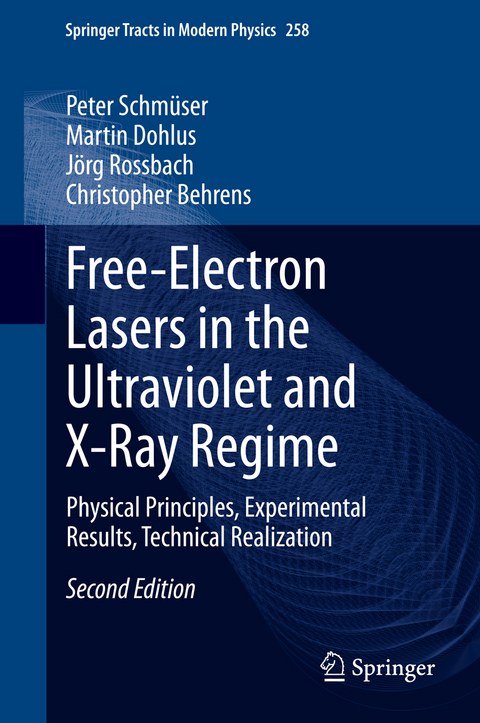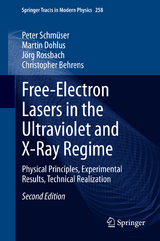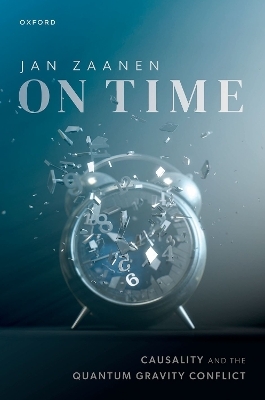Free-Electron Lasers in the Ultraviolet and X-Ray Regime
Springer International Publishing (Verlag)
978-3-319-04080-6 (ISBN)
The main goal of the book is to provide a systematic and didactic approach to the physics and technology of free-electron lasers. Numerous figures are used for illustrating the underlying ideas and concepts and links to other fields of physics are provided. After an introduction to undulator radiation and the low-gain FEL, the one-dimensional theory of the high-gain FEL is developed in a systematic way. Particular emphasis is put on explaining and justifying the various assumptions and approximations that are needed to obtain the differential and integral equations governing the FEL dynamics. Analytical and numerical solutions are presented and important FEL parameters are defined, such as gain length, FEL bandwidth and saturation power. One of the most important features of a high-gain FEL, the formation of microbunches, is studied at length. The increase of gain length due to beam energy spread, space charge forces, and three-dimensional effects such as betatron oscillations and optical diffraction is analyzed. The mechanism of Self-Amplified Spontaneous Emission is described theoretically and illustrated with numerous experimental results. Various methods of FEL seeding by coherent external radiation are introduced, together with experimental results. The world's first soft X-ray FEL, the user facility FLASH at DESY, is described in some detail to give an impression of the complexity of such an accelerator-based light source. The last chapter is devoted to the new hard X-ray FELs which generate extremely intense radiation in the Angstrøm regime. The appendices contain supplementary material and more involved calculations.
Peter Schmüser studierte Physik in Hamburg, verfasste 1964 seine Diplomarbeit in Festkörperphysik, die Dissertation folgte 1967 in Elementarteilchenphysik. Mehrjähriger Forschungsaufenthalt an der University of Michigan. Von 1973 bis 2004 war er Professor für Experimentalphysik an der Universität Hamburg, Schwerpunkte Elementarteilchen- und Beschleunigerphysik.
Introduction.- Undulator Radiation.- Low-Gain FEL Theory.- One-Dimensional Theory of the High-Gain FEL.- Applications of the High-Gain FEL Equations.- Energy Spread, Space Charge and 3D Effects.- Self-Amplified Spontaneous Emission and FEL Seeding.- The EUV and Soft X-Ray FEL in Hamburg.- X-Ray Free-Electron Lasers: Technical Realization and Experimental Results.- Appendices.- A. Hamiltonian Formalism.- B. Supplements to Chapter 4.- C. Gaussian Modes of Laser Beams.- D. Eigenmode Approach.- E. Statistical Methods and Tools.- F. Conventions and Frequently used Symbols.- Index.
| Erscheint lt. Verlag | 6.3.2014 |
|---|---|
| Reihe/Serie | Springer Tracts in Modern Physics |
| Zusatzinfo | XV, 231 p. 114 illus., 111 illus. in color. |
| Verlagsort | Cham |
| Sprache | englisch |
| Maße | 155 x 235 mm |
| Gewicht | 520 g |
| Themenwelt | Naturwissenschaften ► Physik / Astronomie ► Hochenergiephysik / Teilchenphysik |
| Naturwissenschaften ► Physik / Astronomie ► Optik | |
| Technik ► Elektrotechnik / Energietechnik | |
| Schlagworte | Accelerator-based Light Source • Accelerator DESY • Calculation Free Electron Laser • FEL Physics • FEL Review • Free Electron Lasers Reviewed • High-gain FEL • High Gain Free Electron Laser • Laser • Performance Free Electron Laser • Soft X-Ray FEL • X-ray Free Electron Laser |
| ISBN-10 | 3-319-04080-4 / 3319040804 |
| ISBN-13 | 978-3-319-04080-6 / 9783319040806 |
| Zustand | Neuware |
| Informationen gemäß Produktsicherheitsverordnung (GPSR) | |
| Haben Sie eine Frage zum Produkt? |
aus dem Bereich




